This post may contain affiliate links. Please read our disclosure policy.
This vegan dried tomato camembert is garlicky, cheesy, savory, and packed with an intense tomato flavor! It has a tender and incredibly creamy texture and is naturally coated with a white and fluffy rind. Made with just 12 wholesome ingredients, you have to try this cheese!

You may know that my favorite cheese recipe to date is my hickory-smoked cheese. Well, in all honesty, this one comes very close. And it’s not any vegan cheese – it’s a camembert infused with an intense dried tomato flavor!
I wanted to share this recipe with you sooner, but it took me a while to tweak each ingredient. My main problem was that the cheeses were way too salty because I was using store-bought sun-dried tomatoes, usually packed with salt. To fix this problem, I decided to make my own salt-reduced dried tomatoes. It takes a bit longer to prepare, but at least you know (and can brag) that you made everything from scratch!
If you have ever made vegan camembert before, you will see the base remains the same, but the taste is totally different. It’s garlicky, slightly herby, and so savory.
Honestly, have you ever seen a dairy camembert like this?!
⭐️ Why You Should Try It
A camembert like you have never tried.
Unless I am mistaken, there is no dairy camembert that has dried tomatoes blended into it. The reason is that it would be difficult to do because of the process of curdling and draining the milk. But that’s completely doable with vegan cheese!
Since there is no curdling or draining happening with cashew-based cheeses, it’s possible to blend dried tomatoes directly into the cream cheese! The result is a cheese that features a lovely orange hue, beautifully contrasted by its white crust.
Packed with umami goodness.
Imagine a cheese that is super savory, loaded with an intense garlicky tomato flavor and a hint of herbs. The natural bloomy rind adds to that a mushroomy aroma and floral notes. This dried tomato camembert is truly unique, and I’m confident you have never tried anything like it!
Made with wholesome ingredients.
You won’t need any starch or gum to make this cheese. It only relies on wholesome ingredients such as cashews, tomatoes, nutritional yeast, herbs, and cultures.
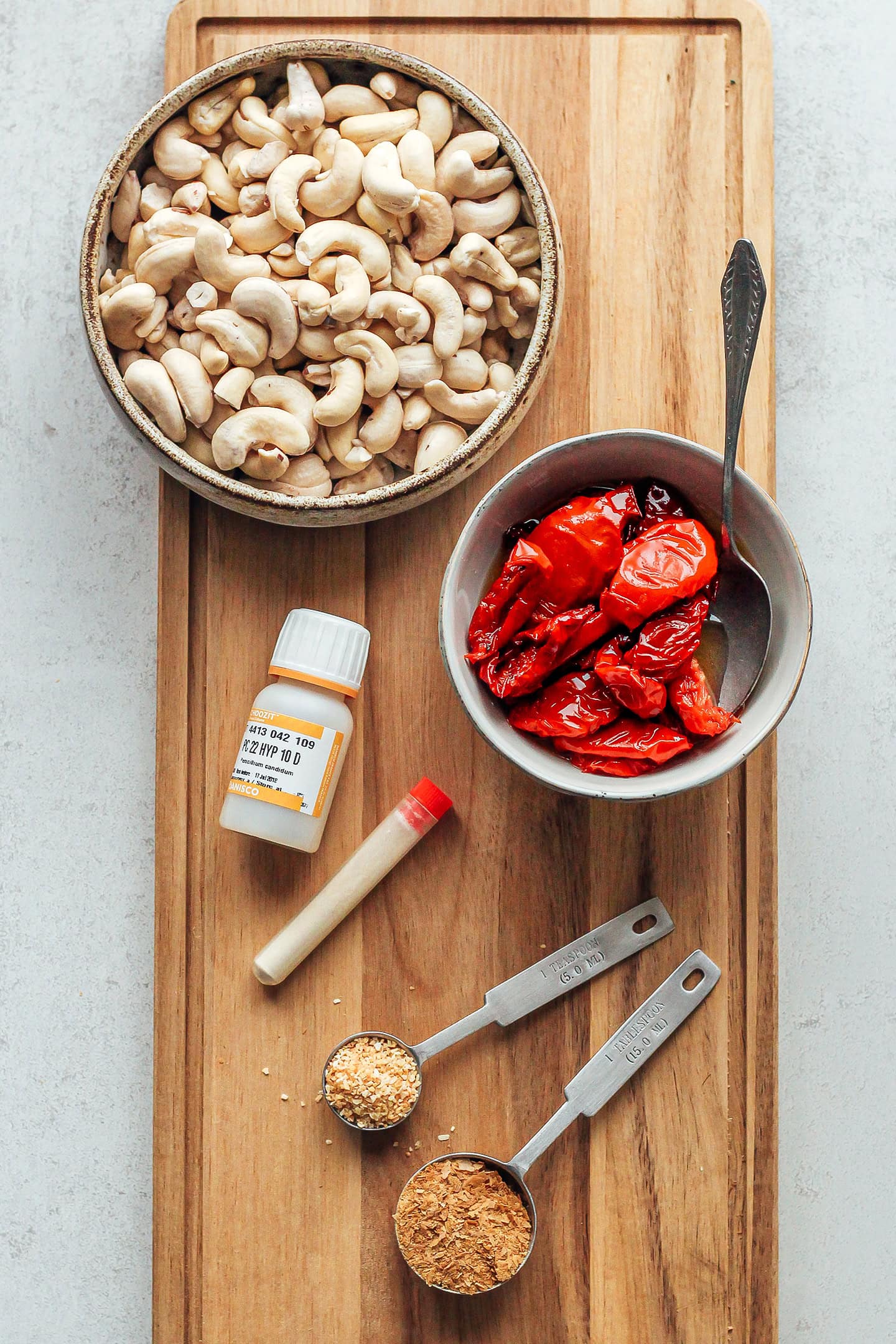
🍅 Ingredient Notes
Cashews
I love to use raw cashews as a base to make vegan cheese for a few reasons. First, they create a rich and creamy consistency. Second, they can be cultured just like real dairy cheese!
Tip: To prevent bad mold from growing, I recommend adding your soaked and drained cashews to a bowl and covering them with boiling water. Allow them to sit for 1-2 minutes before draining them again and letting them cool down. This extra step will kill possible harmful bacteria.
Cultures
Cultures are essential in this recipe as they bring natural tanginess, umami, and a buttery flavor.
The first type of culture you will need is either Acidophilus probiotics or Mesophilic Culture. Similar to a yogurt starter, it allows the cashew cream to ferment. It’s responsible for the tanginess of your cheeses.
Note: I have tried this recipe with both probiotics and mesophilic cultures. The probiotics yield a tangier taste, while the mesophilic creates more buttery notes.
Recommendation: For the probiotics, I recommend using Acidophilus from the brand Solgar. Each capsule contains 500M micro-organisms, and I use a total of 6 capsules. If using mesophilic, only use 1/16 of a teaspoon.
The second culture required is called a ripening culture. In this recipe, I use a mold powder called Penicillium Candidum. It won’t create fermentation but is responsible for the growth of the white and fluffy rind, which is characteristic of camembert, as well as the mushroom aroma.
Note: Remember that Penicillium Candidum is not always vegan, as the mold can be grown on lactose. You can find vegan versions by doing a quick search online -they’re quite easy to find nowadays. In case you are really unlucky and can’t get your hands on a vegan culture, feel free to use the regular one. Your cheeses won’t be 100% vegan, but they will be quite close, considering the tiny amount of culture used.
Tomatoes
Dried tomatoes have rich, complex flavors that develop through the drying process. They add an intense tomato flavor and umami to this camembert.
Instead of using store-bought dried tomatoes, I make my own. Why? The main reason is to control the amount of salt.
See, the sun-dried tomatoes stored in oil that you can buy at the supermarket are usually very salty, and since you have to salt the exterior of the cheese for better mold development, it results in an extremely salty, unpleasant flavor. To prevent that, I make my own and use a very small amount of salt. Don’t worry – making your own dried tomatoes is not as complicated as it sounds!
Nutritional yeast
The addition of nutritional yeast is optional but brings more cheesiness and umami.
Garlic and onion powder
Garlic and onion powder complement the tomato flavor. Do not replace them with fresh onion or garlic. Powders work best in this recipe as they pack a more intense flavor.
Thyme and oregano
I like to add some dried thyme and oregano to add an herbaceous flavor. Feel free to use your favorite dried herbs. Rosemary, sage, or basil work well too.
Salt
Salt does three things: 1) It prevents bad mold from appearing. 2) It boosts the development of the white mold, also called Penicillium Candidum. And 3) It removes excess moisture from the cheeses, making them firmer.
🥣 How to Make It
1. Dry the tomatoes
- Preheat the oven. Start by preheating your oven to 200°F (94°C). Line a baking sheet with parchment paper and set aside.
- Prepare the tomatoes. Rinse the tomatoes under cold water and pat them dry using kitchen paper towels. Cut the tomatoes into quarters and remove the core. Scoop out the seeds and pulp and discard them.
- Season them. Transfer the quartered tomatoes to a mixing bowl. Add the olive oil, thyme, oregano, and salt. Toss to coat.
- Transfer to a baking dish. Arrange the tomatoes on the baking sheet, cut-side up. Make sure to leave space between each one. You don’t want them to touch each other. Note: Depending on the size of your oven, you might have to use two baking sheets.
- Bake. Bake the tomatoes for 4 hours or until they have reduced in size by about half. Remove from the oven and let them cool completely.
How to store dried tomatoes
If you don’t plan to use the dried tomatoes right away (or if you have made a double batch), you can transfer them to a glass container and cover them with canola or sunflower oil. Dried tomatoes can be stored in the refrigerator for up to 6 weeks. Pat them with kitchen paper towels to remove the oil before using them.
2. Blend the cashew mixture
Once your tomatoes are ready, it’s time to prepare the cashew cream. To do so:
- Combine all of the ingredients. Place the soaked and drained cashews, dried tomatoes, nutritional yeast, garlic powder, onion powder, and two tablespoons of water in a blender.
- Blend. Blend on high speed, scraping down the sides from time to time. This step might take about 10 minutes, depending on your blender. You want a very smooth yet thick texture. If needed, add 1 tablespoon of water at a time until smooth. Do not add too much water, or the cheeses will be very hard to handle during the aging step.
- Add the cultures. Open the probiotic capsules and add the powder to the bowl. You can use a mesophilic culture starter instead if you prefer (both work). Add the Penicillium Candidum as well. Blend for another few seconds.
- Transfer to a bowl. Once your mixture is smooth, transfer it to a clean bowl. At this step, you can stir in some chopped dried tomato pieces if you want more texture. Cover the bowl with plastic wrap touching the mixture – this will prevent the top from drying.
- Let it ferment. Let the cashew cream ferment at room temperature for 12-36 hours. After about 12 hours, taste the cashew cream. It should have a slightly sour taste, like fresh cream cheese. If it doesn’t and still has a strong cashew flavor, let it sit on the counter for another 12 hours.
- Chill. Once cultured, place the bowl in the refrigerator for at least 4 hours, preferably overnight. Once cold, the cashew cream will be slightly firmer and easier to work with.
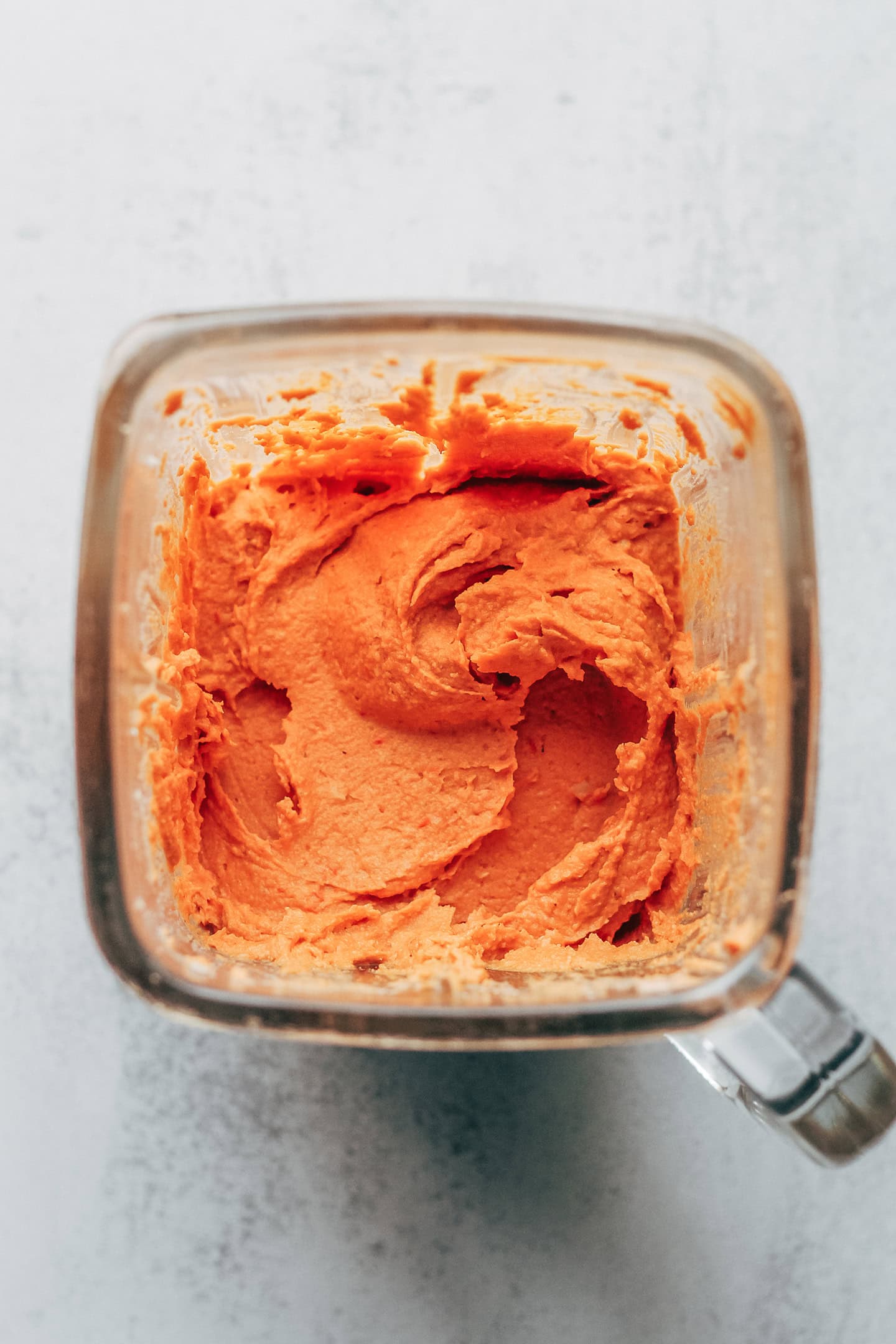
3. Shape the cheeses
Now that the cashew cream cheese is ready, you can shape it into wheels. To do so:
- Prepare the pans. Cut strips of parchment paper and lay them into three 4-inch (10 cm) springform pans to cover the sides and bottom. The goal is to prevent the cream cheese from touching and sticking to the metal. Alternatively, you can use food rings like these to shape the cheeses. No parchment paper? Simply use cling film.
- Fill pans with the cream cheese. Fill the pans with the cashew cream and press it down using plastic film so it doesn’t stick to your hands. Try to make the top as flat as possible (it will result in a nicer shape).
- Refrigerate. Cover each springform pan with plastic wrap touching the cream cheese, and refrigerate overnight.
4. Age them
- Salt the cheeses. Line a deep container with parchment paper. Carefully remove the wheels of cheese from the springform pans and place them inside the container. Sprinkle about 1/4 tsp of salt over the top of each cheese, flip them, and sprinkle another 1/4 tsp on the other sides. Rub with your finger to distribute the salt evenly on each face and on the sides. Close the container containing the cheeses and place it in the refrigerator.
Regarding the aging temperature
This recipe can be made in a regular fridge, but you will have to increase the temperature slightly. Penicillium Candidum, which is the mold responsible for the white rind, grows faster and better at slightly higher temperatures. I recommend a minimum of 45°F (7°C) and a maximum of 57°F (14°C) to age your cheeses.
- Flip the cheeses. Every day for the next 3 days, carefully flip the cheeses. In the beginning, the cheeses will still be very soft, like cream cheese, which makes them a bit difficult to handle. Don’t worry, they will be easier to work with after a few days. Always place the container back inside the refrigerator after flipping the cheeses.
- Age them. Continue to flip the cheeses every day for the next two weeks, leaving them in the container inside the refrigerator all the time. Always use clean hands or work with plastic film to ensure you are not touching the cheeses. The mold will start to appear on days 8-10, depending on the humidity and temperature of your fridge. Once the mold has started to appear, you can transfer the cheeses to a plastic grid or bamboo mat or put them on top of chopsticks to allow the mold to grow better (still leaving them in the refrigerator, covered). After another week or so, the cheeses should be fully covered with white mold!
- Wrap them. Once the cheeses are completely coated with a layer of white mold, wrap them in parchment paper or cheese paper and place them in the refrigerator for at least 5 days. The longer you let them age in the refrigerator, the stronger the taste. They are then ready to be enjoyed!

📔 Tips
Use clean tools and utensils.
Hygiene is extremely important in cheese making. The cleaner your tools and utensils are, the better your chances of not seeing bad mold. One more thing: to increase your chances of success, I highly recommend using gloves while handling the cheeses.
Keep the cheeses covered.
You should always keep the cheeses inside a container or covered with a bowl or glass container. By covering the cheeses, you keep enough moisture to allow the white mold to grow. If you don’t cover the cheeses, the exterior will dry too quickly, and the mold will never appear.
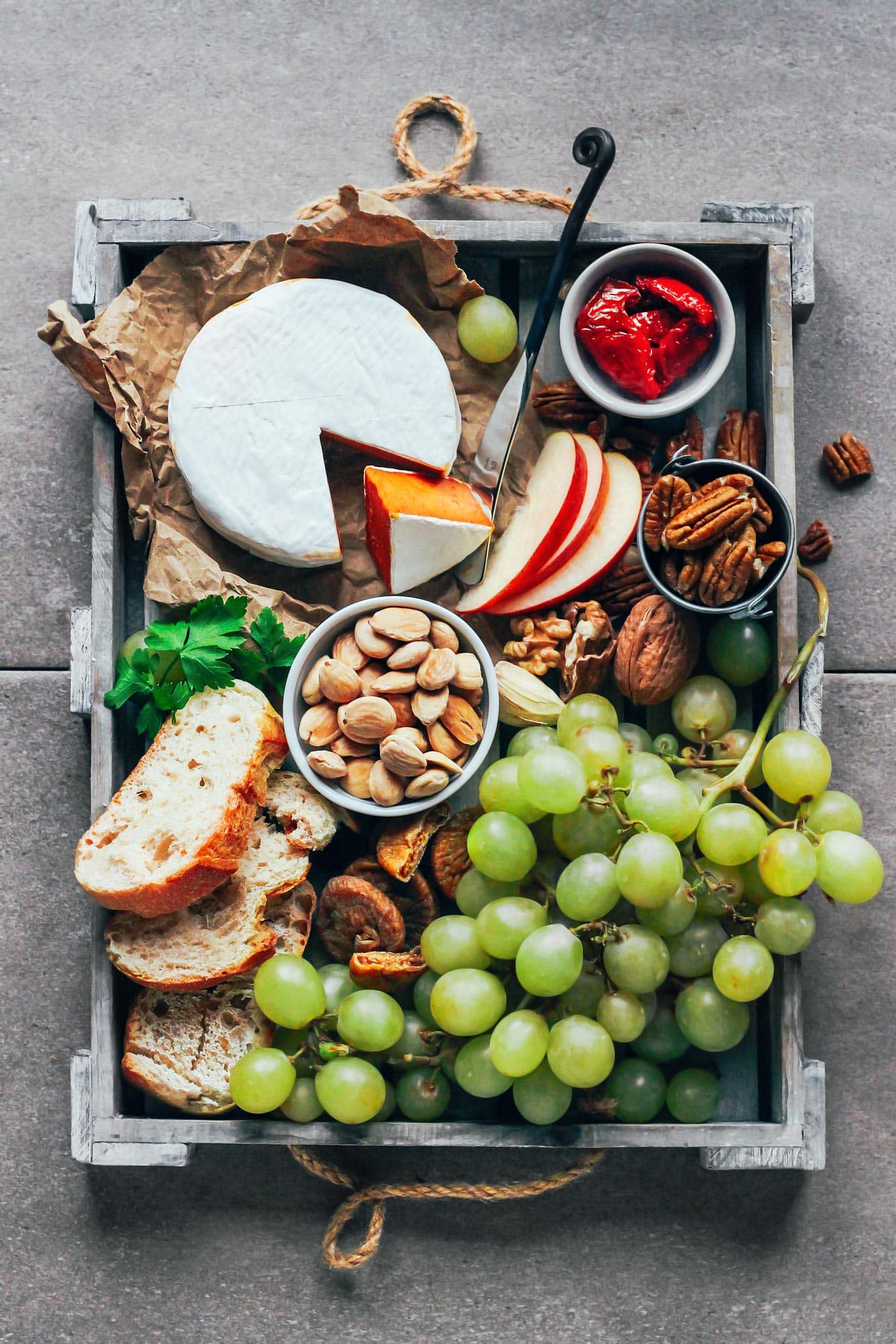
🥖 What to Serve It With
You can enjoy this dried tomato camembert in the most simple way, or should I say the French way, with baguette and a glass of wine – or serve it on a cheese platter with nuts, crackers, grapes, and dried fruits!
It can also be blended with some vegan cream to make a luscious pasta sauce or diced into chunks to incorporate into casseroles!

❄️ Storing and Freezing
- To store: You can store this cheese for up to 1 month after the aging process.
- To freeze: Wrap it with plastic wrap and freeze for up to 3 months. Thaw overnight in the refrigerator.
💬 FAQ
Probiotics and Penicillium Candidum are essential to this recipe. They cannot be omitted.
I do not advise trying to age the cheeses at room temperature as bad mold would grow, and your cheeses would turn bad.
Sure! Don’t stress it if you are away and can’t flip the cheeses for 2-3 days. It’s completely fine.
You should scrape off the bad mold using a sharp knife and add a pinch of salt to the area you scraped. If there is really too much bad mold, then your only option is to start again and ensure your utensils and container are as clean as possible.
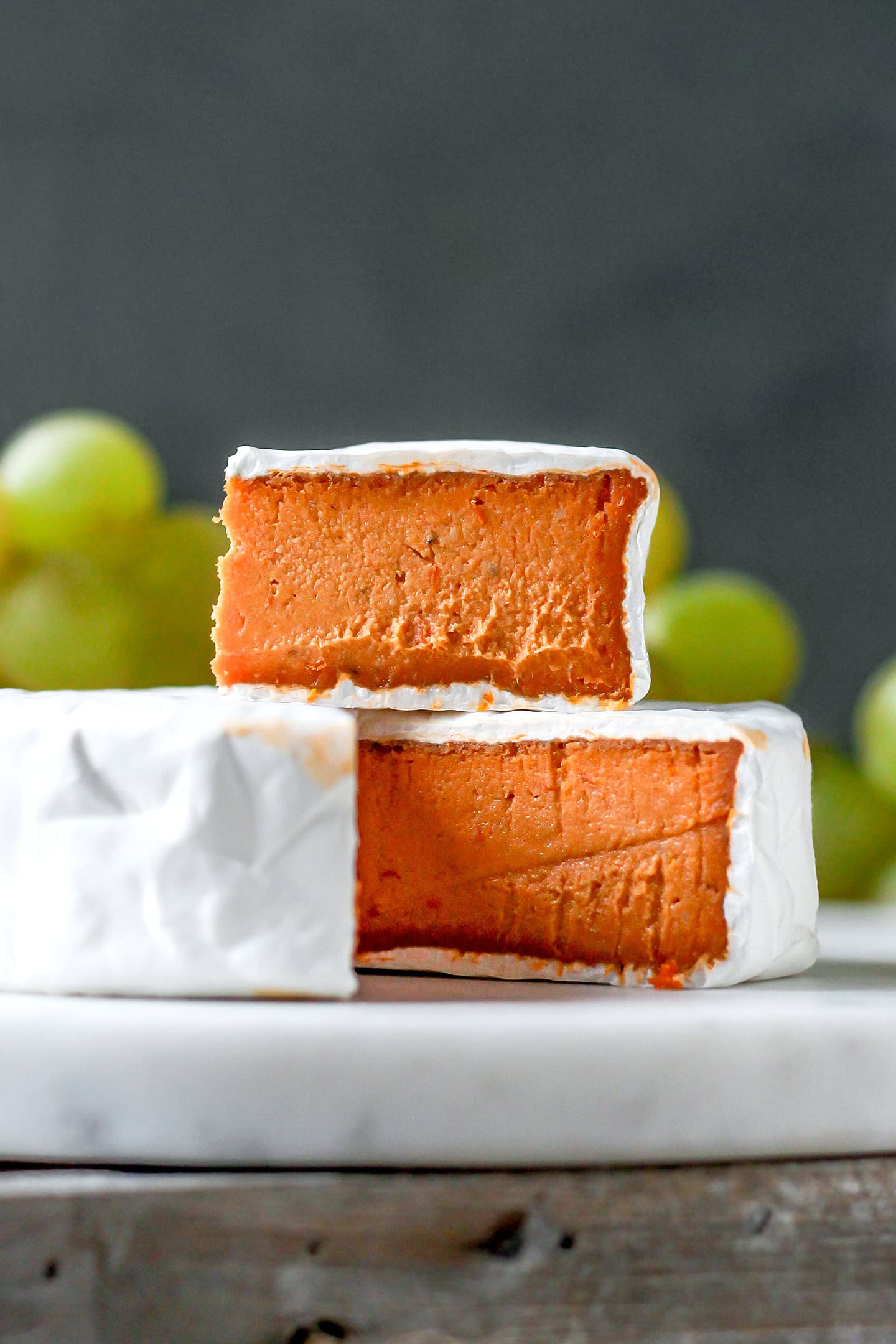
Whether you’re just starting out with vegan cheese making or have been at it for years, you’re going to love this recipe! This vegan tomato camembert is a fun project to do during the holidays, and the result will surely wow your guests!
🧀 More Vegan Cheese Recipes
⭐️ Did you like this recipe? Let us know in the comments below, and tag us on Facebook, Instagram, or Pinterest!
Note: This recipe was first released in November 2017 and updated with new process shots and detailed instructions in November 2024.
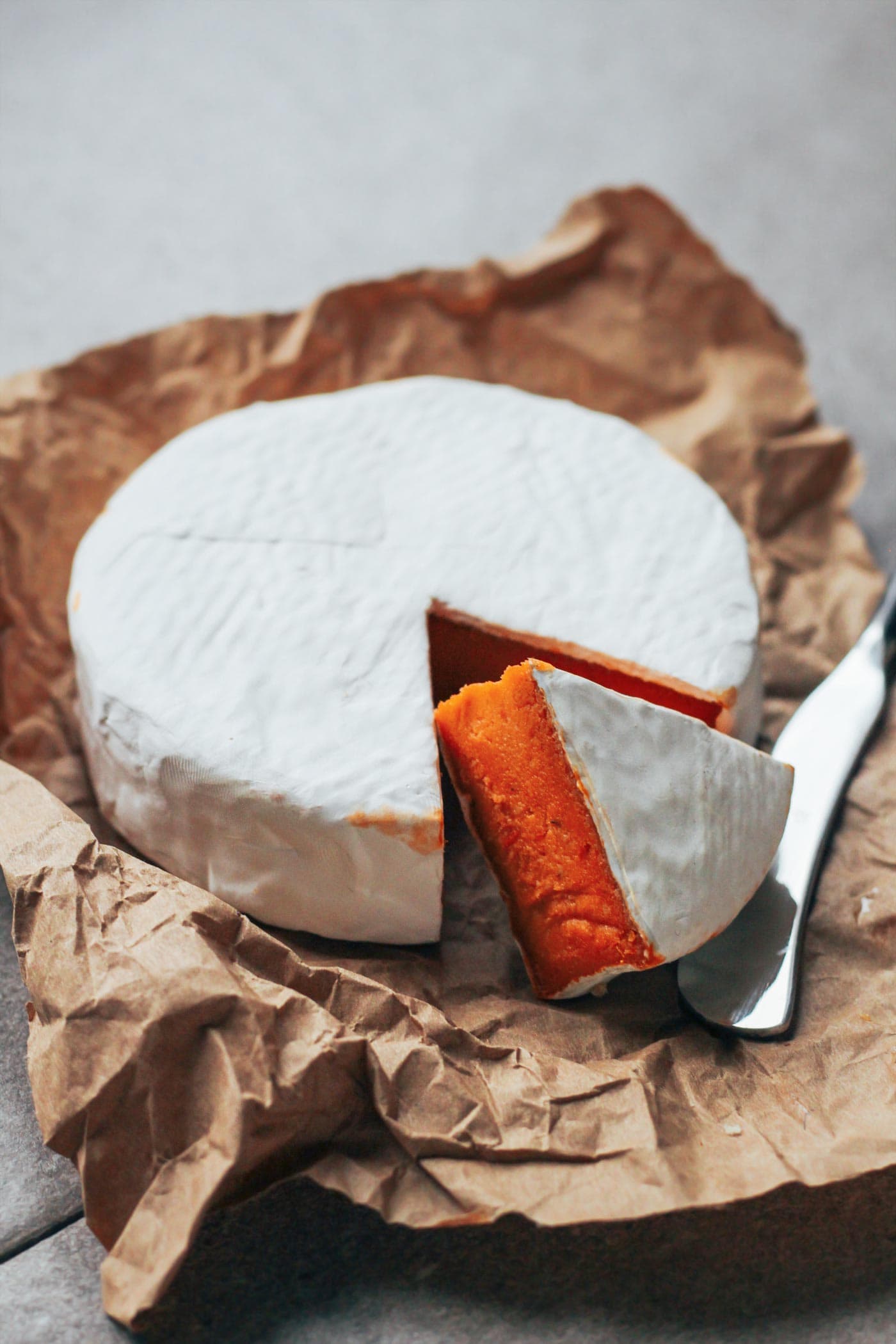

Save this recipe!
Enter your email below and I’ll send it to your inbox!
Plus, you will receive new recipes every week!
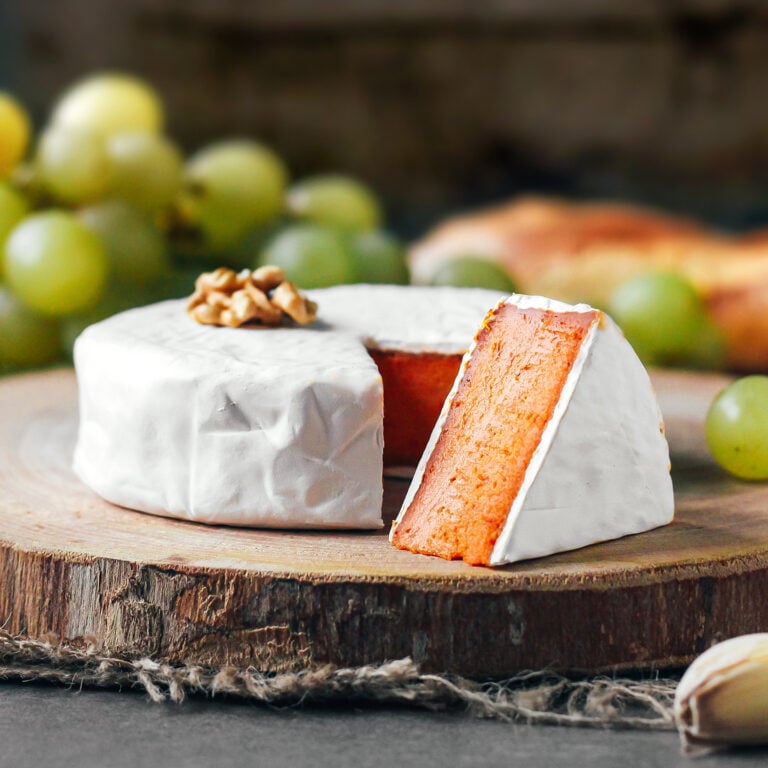
Vegan Sun-Dried Tomato Camembert
Ingredients
Dried Tomatoes
- 10 fresh large tomatoes
- 1 tbsp olive oil
- 1/4 tsp thyme
- 1/4 tsp oregano
- 1/8 tsp salt
Camembert
- 4 cups raw cashews soaked overnight
- 3/4 cup packed dried tomatoes (drained if stored in oil)
- 1 tbsp nutritional yeast
- 1 and 1/2 tsp garlic powder
- 1 tsp onion powder
- 5 tbsp water
- 6 capsules acidophilus or 1/8 tsp mesophilic culture
- 1/16 tsp penicillium candidum
- salt for salting the cheeses
- optional: 1/4 cup chopped dried tomatoes to incorporate into the cream cheese
Instructions
Dry the tomatoes
- Preheat the oven. Start by preheating your oven to 200°F (94°C). Line a baking sheet with parchment paper and set aside.
- Prepare the tomatoes. Rinse the tomatoes under cold water and pat them dry using kitchen paper towels. Cut the tomatoes into quarters and remove the core. Scoop out the seeds and pulp and discard them.
- Season them. Transfer the quartered tomatoes to a mixing bowl. Add the olive oil, thyme, oregano, and salt. Toss to coat.
- Transfer to a baking dish. Arrange the tomatoes on the baking sheet, cut-side up. Make sure to leave space between each one. You don’t want them to touch each other. Note: Depending on the size of your oven, you might have to use two baking sheets.
- Bake. Bake the tomatoes for 4 hours or until they have reduced in size by about half. Remove from the oven and let them cool completely.
- Note: If you don’t plan to use the dried tomatoes right away (or if you have made a double batch), you can transfer them to a glass container and cover them with canola or sunflower oil. Dried tomatoes can be stored in the refrigerator for up to 6 weeks. Pat them with kitchen paper towels to remove the oil before using them.
Blend the cashew mixture
- Optional: Drain the soaked cashews and place them in a large glass bowl. Bring a large pot of water to a boil. Pour the boiling water over the cashews and allow them to sit for 1-2 minutes before draining them again and letting them cool down. This extra step will kill possible harmful bacteria.
- Combine all of the ingredients. Place the soaked and drained cashews, dried tomatoes, nutritional yeast, garlic powder, onion powder, and two tablespoons of water in a blender.
- Blend. Blend on high speed, scraping down the sides from time to time. This step might take about 10 minutes, depending on your blender. You want a very smooth yet thick texture. If needed, add 1 tablespoon of water at a time until smooth. Do not add too much water, or the cheeses will be very hard to handle during the aging step.
- Add the cultures. Open the probiotic capsules and add the powder to the bowl. You can use a mesophilic culture starter instead if you prefer (both work). Add the Penicillium Candidum as well. Blend for another few seconds.
- Transfer to a bowl. Once your mixture is smooth, transfer it to a clean bowl. At this step, you can stir in some chopped dried tomato pieces if you want more texture. Cover the bowl with plastic wrap touching the mixture – this will prevent the top from drying.
- Let it ferment. Let the cashew cream ferment at room temperature for 12-36 hours. After about 12 hours, taste the cashew cream. It should have a slightly sour taste, like fresh cream cheese. If it doesn’t and still has a strong cashew flavor, let it sit on the counter for another 12 hours.
- Chill. Once cultured, place the bowl in the refrigerator for at least 4 hours, preferably overnight. Once cold, the cashew cream will be slightly firmer and easier to work with.
Shape the cheeses
- Prepare the pans. Cut strips of parchment paper and lay them into three 4-inch (10 cm) springform pans to cover the sides and bottom. The goal is to prevent the cream cheese from touching and sticking to the metal. Alternatively, you can use food rings like these to shape the cheeses. No parchment paper? Simply use cling film.
- Fill pans with the cream cheese. Fill the pans with the cashew cream and press it down using plastic film so it doesn’t stick to your hands. Try to make the top as flat as possible (it will result in a nicer shape).
- Refrigerate. Cover each springform pan with plastic wrap touching the cream cheese, and refrigerate overnight.
Age them
- Salt the cheeses. Line a deep container with parchment paper. Carefully remove the wheels of cheese from the springform pans and place them inside the container. Sprinkle about 1/4 tsp of salt over the top of each cheese, flip them, and sprinkle another 1/4 tsp on the other sides. Rub with your finger to distribute the salt evenly on each face and on the sides. Close the container containing the cheeses and place it in the refrigerator.
- Flip the cheeses. Every day for the next 3 days, carefully flip the cheeses. In the beginning, the cheeses will still be very soft, like cream cheese, which makes them a bit difficult to handle. Don’t worry, they will be easier to work with after a few days. Always place the container back inside the refrigerator after flipping the cheeses.
- Age them. Continue to flip the cheeses every day for the next two weeks, leaving them in the container inside the refrigerator all the time. Always use clean hands or work with plastic film to ensure you are not touching the cheeses. The mold will start to appear on days 8-10, depending on the humidity and temperature of your fridge. Once the mold has started to appear, you can transfer the cheeses to a plastic grid or bamboo mat or put them on top of chopsticks to allow the mold to grow better (still leaving them in the refrigerator, covered). After another week or so, the cheeses should be fully covered with white mold!
- Wrap them. Once the cheeses are completely coated with a layer of white mold, wrap them in parchment paper or cheese paper and place them in the refrigerator for at least 5 days. The longer you let them age in the refrigerator, the stronger the taste. They are then ready to be enjoyed!
- Enjoy with bread, crackers, pesto, nuts, or even jam. You can store the cheeses for up to 1 month after the aging process.
Notes
Use clean tools and utensils.
Hygiene is extremely important in cheese making. The cleaner your tools and utensils are, the better your chances of not seeing bad mold. One more thing: to increase your chances of success, I highly recommend using gloves while handling the cheeses.Keep the cheeses covered.
You should always keep the cheeses inside a container or covered with a bowl or glass container. By covering the cheeses, you keep enough moisture to allow the white mold to grow. If you don’t cover the cheeses, the exterior will dry too quickly, and the mold will never appear. Note: Nutritional information is an estimate.Nutrition

About the Author
Thomas Pagot is the founder, photographer, and recipe developer behind Full of Plants. He created the blog in 2016 as a personal cookbook for vegan recipes. Through years of recipe development, Thomas has successfully grown Full of Plants into a trusted resource for plant-based recipes.



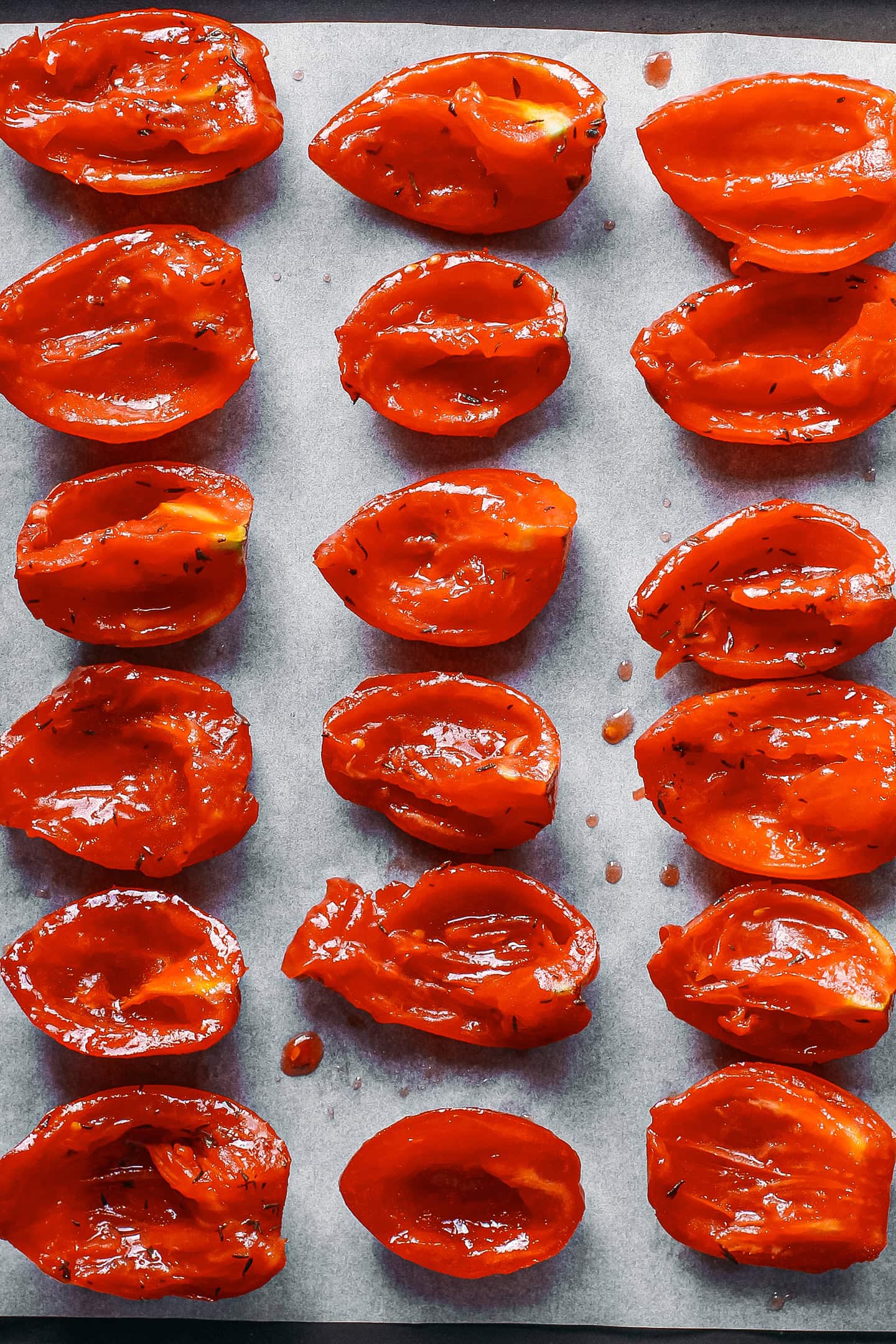
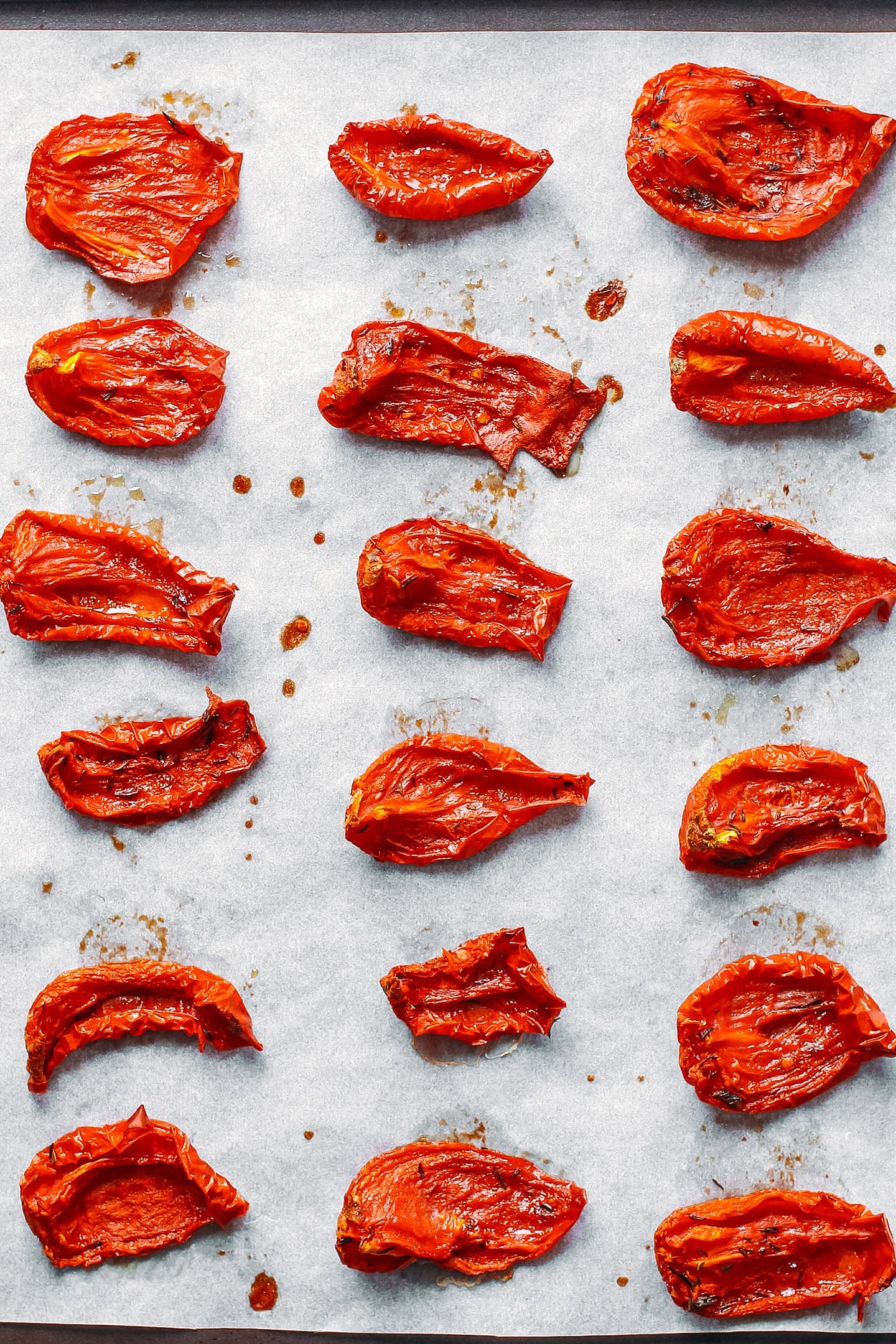
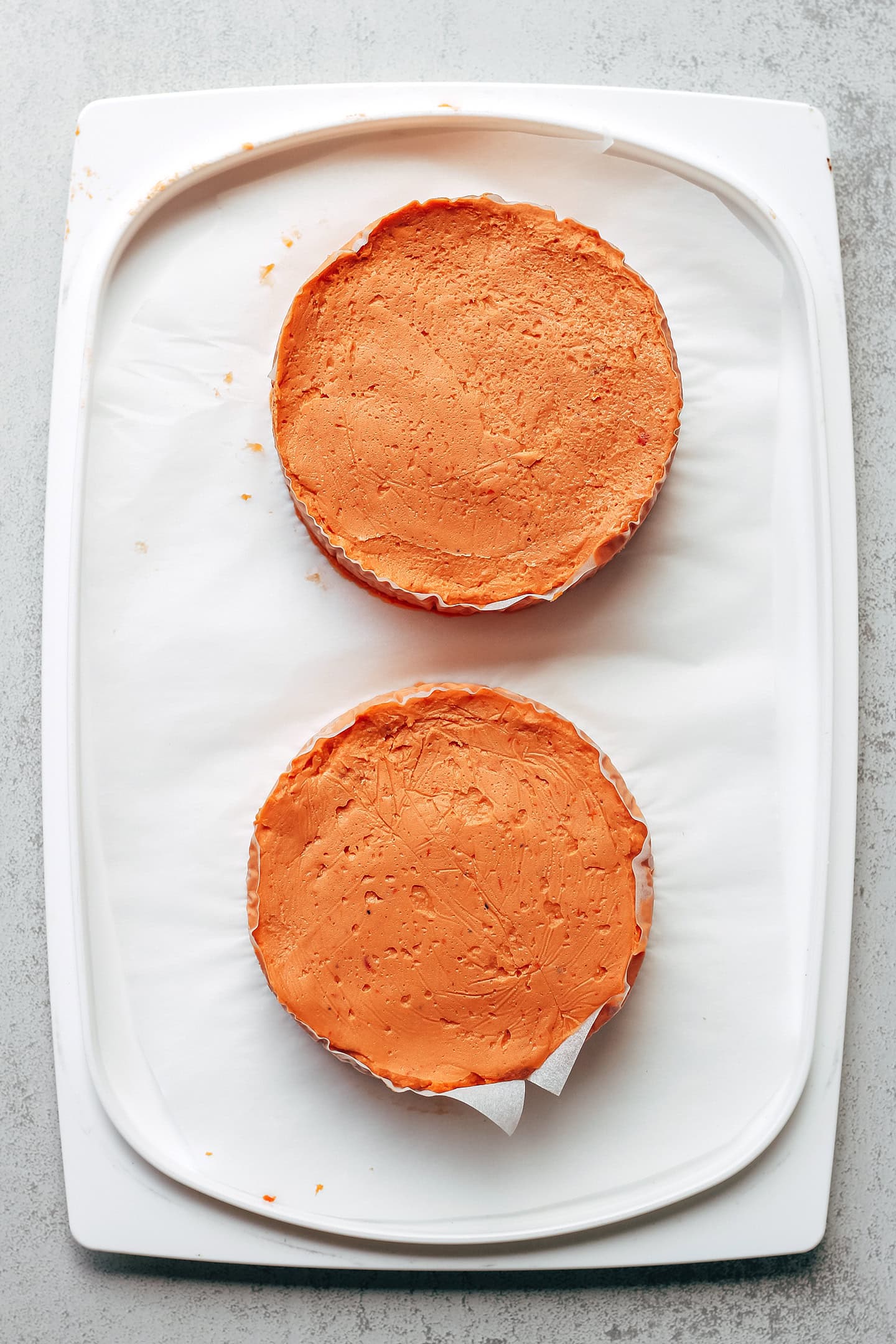

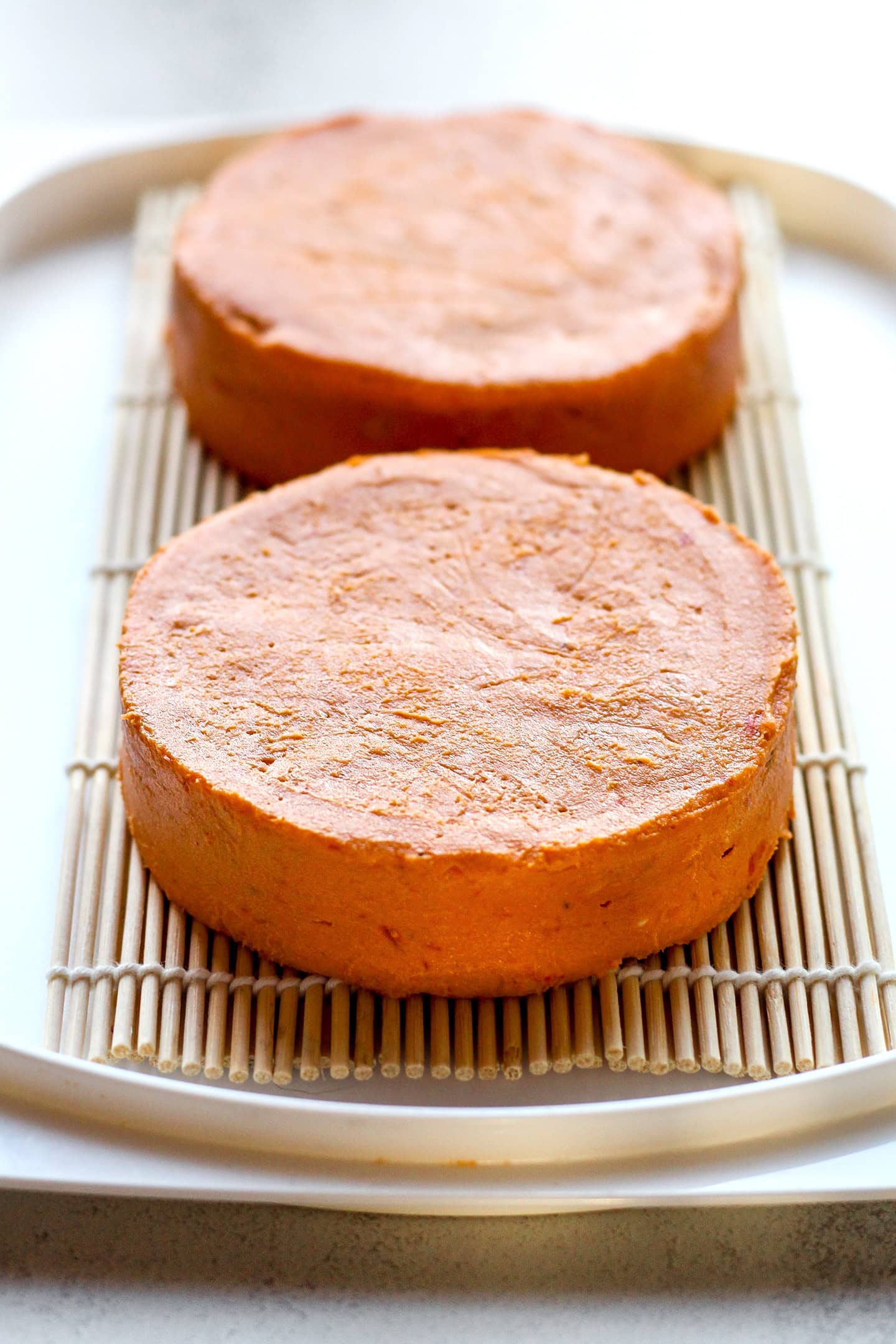
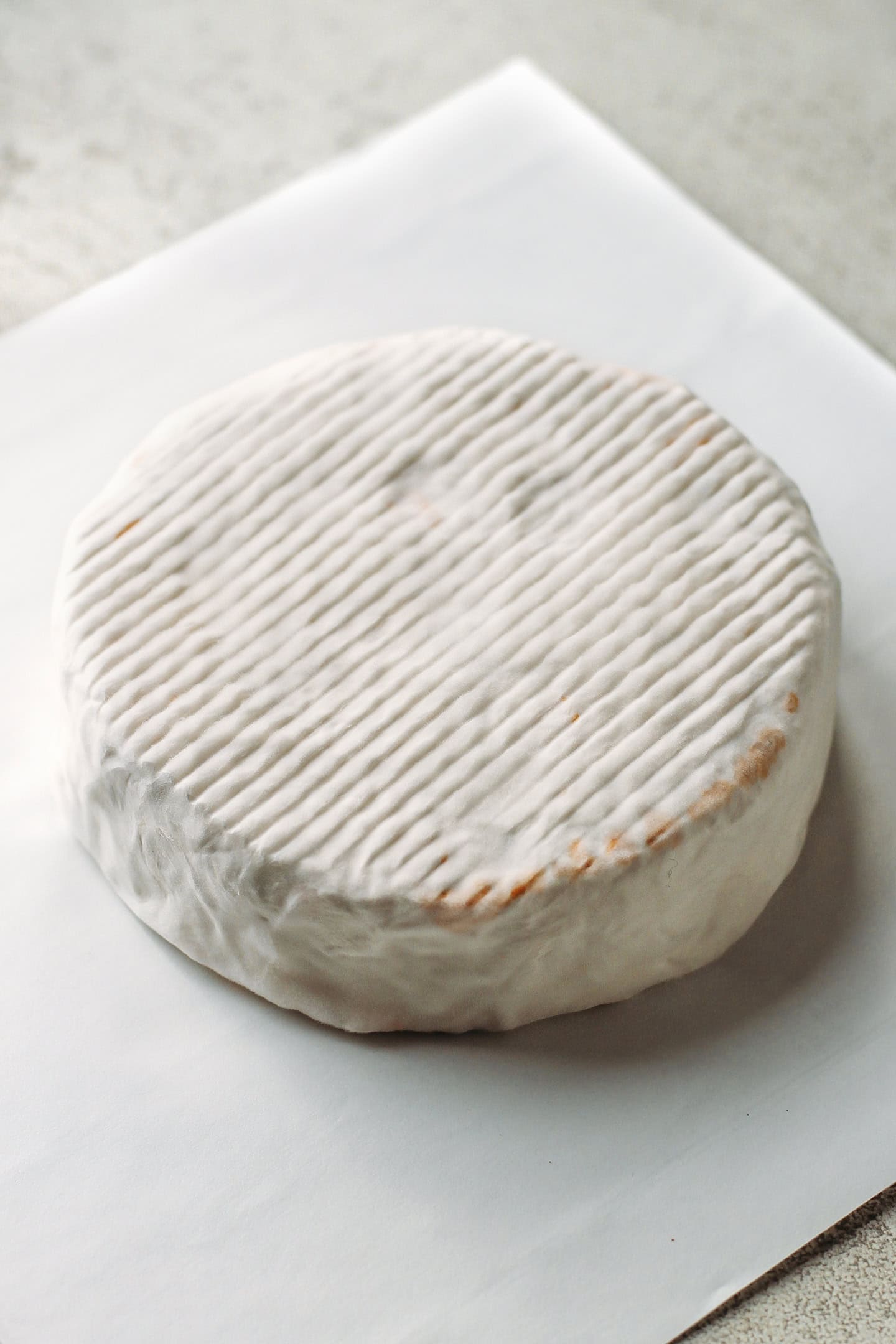




Leave a Comment
Hi. I have a quick question. I know that this recipe makes 3 cheeses. Would it be possible to freeze the cultured cashew cream just before putting the mixture into the springform pans? It would just be me eating the cheese, and I don’t need three at once.
Hi Ariana,
I’m afraid I have never tried this. I would probably age the three cheeses instead and then freeze the 2 aged ones once they are ready.
Okay, thanks!
Genius!! How do you come up with such creative ideas? 😮
This camembert is incredibly delicious and truly one-of-a-kind. I’ll be making this one very often.
Thank you for sharing this recipe!
Glad you liked this camembert Vivian ^^
Thanks for your rating!
HELP! You are a genius with food, first of all. But I screwed up and need help :S
I was making this cheese tonight and accidentally grabbed penicillium Roq. not P candidum. Should I add the P candidum? or am I going to end up with a tomato blue cheese? How would I handle it differently? Thank you for your amazing vegan cheeses book, it has been a treasure.
Thanks Connie 😉
You will end up with a tomato blue cheese I’m afraid. Adding P. candidum would just result in a mix of molds (you would get some white patches as well as blue ones).
I would simply try aging it as normal, knowing it won’t be a camembert 🙂
Your vegan cheeses look delicious!
But I’m writing out of concern that your suggestion to raise refrigerator temperatures to 50°F could raise the likelihood of people getting food-borne illnesses from other foods in the same fridge (such as Bacillus Cereus growing in cooked rice). In the US, government food safety advice is rather adamant that we should be keeping the majority of our refrigerated foods at a temperature lower than 40°F.
Thanks Claire!
Personally, I have used my main fridge with a temperature of 50°F in the past to make vegan cheese and never had any issues. I still recommend using a separate fridge (or wine fridge) for cheese-making, though.
Hi Thomas,
I was wondering, can I use cherry tomatoes instead of large tomatoes? Drying large tomatoes takes so long… And if so, how many tomatoes do I put in the cheese? Something like 500 grams?
I hope to hear from you! Thanks in advance!
Hi Ida,
Yes that will work with cherry tomatoes as well! It will be a little bit shorter to dry them, but not that much less.
Regarding the amount, I am not very sure. I would say about 800g of fresh cherry tomatoes.
Is there a way to dry the tomatoes in an air fryer?
I do not own an air fryer and never used one so I’m afraid I have no idea if that is possible, sorry.
Hi Thomas, have you experimented with harder cheeses like cheddar or dubliner yet? After seeing your recipes for camembert and blue cheese I feel like anything is possible.
Hi Robert,
I did but unfortunately didn’t get good results, even after months of aging.
Hi Thomas,
I think I miss read your quantity for the candidum I used double what I should have, so that must have been why the mould grew so quickly. My cheese is now covered with white mould and on track for being ready in a couple of weeks.
Thank you Thomas for your help
Hi Ruth,
I doubt using X2 the amount of penicillium causes the mold to grow that much faster. It shouldn’t cause any problem though.
Hi again Thomas,
Just turned my cheeses over and white mould is starting to grow already only a day after making the cheese moulds. Do you think it is ok? Thank you for your time, I appreciate it.
Regards
Ruth
Hi Ruth,
One day seems very, very quick. I doubt what you are seing is penicillium candidum. Scrape it off and resalt the area.
Hi Thomas,
I took my cheese mixture out today to put in the moulds and there was white mould growing on top of the cheese under the cling film I had pressed onto the top of the cheese to stop it drying out. I see you say the mould should not appear until around day seven, so I am worrying that my cheese has gone wrong. I did not have a small enough spoon to measure out one eighth of a tea spoon of the penicillium candidum so may have put more in that required. The mould was white. I scraped it off and discarded it.
If you could help me with some advice I would be very grateful,
Regards
Ruth
Hi Ruth,
Don’t worry too much about it, white mold is usually not bad mold. So if you scraped it off you should be good, continue the process.
Omg this looks great but I’m allergic to cashew (my issue with a lot of vegan cheeses) could macadamia nuts be substitute?
I have never tried using other nuts, sorry!
This cheese looks so beautiful. I tried to make it exactly according to the recipe, but the mold would not grow. It did with other cheeses though…………….so the culture was ok. Maybe there was too much acid in the mixture?? Some tomatoes are more acidic than others……… But same thing with the ash-ripened cheese….the white mold had problems growing through. Do you have experience with that problem? And maybe a solution on hand? I would love to give it another try.
I would recommend checking the FAQ in my ebook. Most probably it’s a problem of moisture or temperature.
HI Thomas…………..moisture and temperature were exactly the same in which my plain cashew-brie developed a wonderful white mold.
Looks so delicious and Pure comfort food for sure!
I just tried mine today, I think I need to add more salt but overall it is really good! Thank you so much Thomas ,it was so surprisingly easy to make! I will be starting a new batch tomorrow, I was thinking of may be adding roasted red pepper inside, will be interesting to see if that will work nice 🙂 the blue cheese is maturing in the fridge as well, excited to see how that would turn up 🙂
Awesome! So glad it turned out great for you! Thanks for your feedback 🙂
Hello Thomas,
Excellent recipes excellent blog, please add more recipes.
You are very precise and I like it.
I am vegetarian but interested with vegan recipes.
I like to do mimetic cooking and imitate meat and cheese, without meat and cheese of course.
Best regards.
Demy 🙂
Hi Demian,
Thanks for the kind words! 🙂
Hi! This is really great!!!! I was wondering if you have suggestions on how to make cashew cheese that is solid without using agar-agar or waiting three weeks?
Hi Anna,
I think you should check out cheeses made using tapioca starch or carrageenan. Personally, I prefer real aged cheeses 🙂
I just started the fermenting process today. I just found out I have to leave town for 2 days. I will be @ the start to flip daily after salting process. Will these be ok to sit for two days without flipping?? Or am I going to mess them up completely. 🙁
Hi Tara,
Sorry for the late reply, I guess it’s a bit too late now 🙂
Yes it’s okay if you don’t flip them for 2-3 days, especially at the beginning since the mold hasn’t started to grow yet.
Hi Thomas! Thanks for replying. I got home lastnight (3 days after salting) and the mold has started to grow!! It all looked good. Today when I flipped the mold has some orange-pink tint to it. Could it just be from the paper having some of the sundried tomato color?? Should I remove it? Change the paper? Start over? Or am I ok?? They smell lovely! I am so excited!!
Hi Tara,
That’s great news! Regarding the orange-pink mold do no worry about it 🙂 Its definitely the sundried tomatoes that can color the mold, especially if you haven’t flipped the cheeses for a few days. If you have one, you can now place the cheeses on a clean grid (that fits in your aging container/box as you always want the cheeses to be covered), or simply place the cheeses on chopsticks. Doing this will make the mold grow faster as there will be more surface in contact with air. If you don’t have any grid then make sure to flip the cheeses every day so the mold grows uniformly.
Hope you will like this cheese!
I’m astonished. Your cheese looks absolutely fantastic and sooo tasty.
I love cheese and I went veggie only 3 weeks ago… currently trying to make this journey creative and funny.
I absolutely wanna try your cheese, I will give you your fully earned credit when the big day will come.
Thank you so much for sharing.
You do a wonderful job with your experiments. Great!
Awesome! Thanks for the kind words Penny 😉
Hi Thomas,
My Sundried camembert should be ready in a week, however there are only a few random spots of mould on the outside. I’m not sure why, although I live in Australia and maybe the cheese got too warm/hot during the ‘fermenting’ period – I have no idea. I’m following the recipe exactly, maturing the cheese in the fridge, so this is all I can think is the problem. Are there any remedies and is it ok to eat the cheese if it hasn’t ‘moulded up’ in this way?
Many thanks again – I really appreciate your expertise and generosity.
Hi Thomas! Is the Penicillium Candidum integral to the recipe- helping preserve the cheese and such? I’m on a budget and wondering if I can leave it out. Thanks in advance!
Hi Ursula! Penicillium Candidum is a key element in this recipe, without it you won’t get the camembert flavor or even the white rind.
Thanks so much!
This looks great! Your cheese recipes have inspired me to start making my own cheeses- my sister has promised me a cashewbert kit for christmas and I can’t wait!
Some questions though: have you tried to do anything with transglutaminase yet? And what do you think about adding lactic acid for flavour?
Thanks for all your hard work 🙂
Awesome! Cashewbert has great products!
Yes I tried using translutaminase several times, the results were very good. The rind grows fast, the only downside I found is that the texture is not as rich as cashew-based cheeses, and they turn more acidic very quickly. Meaning you can’t keep them for a month in the refrigerator or they will be too sharp/piquant.
I don’t really use lactic acid, I don’t see the point of using it if you are already using mesophilic or acidophilus cultures. It can be useful if you make quick cheesy sauces that don’t require fermentation.
It looks such delicious. Thanks for sharing the recipes and the fantastic pictures!
You’re welcome Mia!
You’ve done it again Thomas! I can’t wait to try this. Great work!!!
Thank you Kat!
Hi Thomas,
like the idea! My husband immediately liked the recipe too. Such an amazing idea!
Thank you so much for sharing all these great recipes!
You’re welcome Katja!
Another great innovative recipe! Congratulations! The cheese looks so deliciuos. Thank you so much Thomas for sharing your discoveries!
Thanks Madhuja! 😉
Honestly, have you ever seen a dairy camembert like this?!” No we haven’t! This is the logical next step in vegan cheeses I think – using beautiful vegan ingredients (plants) to create something which is conceptually a cheese but is better than the dairy cheeses. These “cheeses” will soon be competing with the dairy cheeses on omnivore’s cheese platters because they are so spectacular and tasty! Go Thomas!
I hope so! Plus, it would be awesome to have more options in stores when it comes to vegan cheese, especially ones made from whole ingredients, not just coconut oil and flavorings.
Glad to hear you like this recipe!
Would you consider starting the trend? I would love to buy your cheeses. This is a very big endeavour AND I have a small fridge… A new business venture for you? There sure is no competition to speak of!
I considered it but then realized I would rather continue working on this blog and experiment/share vegan recipes. There is just more variety, freedom, and creativity involved.
On the other hand, many vegan cheese companies have been created this year, and I’m sure vegan cheese will develop even more in 2018.
Bravo again, Thomas. I am using hazelnuts almost exclusively now, and the ‘hazel’ flavor almost disappears in the culture. Especially with Blue cheese, you get a more complex sharpness, more characteristic of the dairy version. Also it might be valuable to know that anyone can use just a few pine nuts instead of coconut oil, since they contain so much natural oils and develop into a very creamy puree. It seems like you’re now using other ingredients inside the nut base, like sweet miso and other components. Sounds great.
Thanks for sharing Melissa! I definitely have to try blue cheese with hazelnuts soon!
Please stop with pine nuts, you are making me jealous 🙂 I wish I could get as much as you do for a cheap price, but it’s probably the most expensive nut here.
Regarding the other ingredients, I try to use as less as I can for cheeses but in this specific recipe, miso, garlic, and nutritional yeast gives it more complex flavors that pair well with the sundried tomatoes. Thanks for the rating!
That cheese looks amazing! Can you please tell me where I can buy Penicillium Candidum in North America? The product link in the post is no longer available 🙁
I get my cultures from The Cheese Connection in Seattle, WA. They ship all over the US and are great to work with. Both on the phone and via email, they are very helpful.
http://www.cheeseconnection.net/
I LOVE making Thomas’ cheeses! His genius and generosity are unsurpassed!